Multiple bright outbursts have made Comet Leonard stunning photographically and visible without optical aid from southern locations. More disruptions are likely in store as it approaches perihelion.
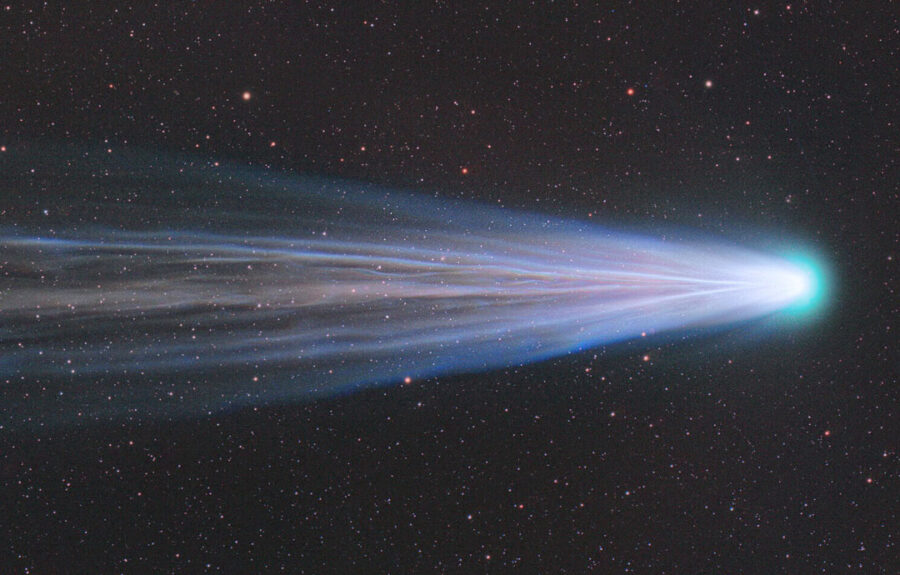
Michael Jäger and Lukas Demetz
Comet Leonard (C/2021 A1), which appeared to stall out around magnitude 5 in early December, has become a surprise performer. Since transitioning to the evening sky, it’s undergone three successive bright outbursts — on December 15th, 20th, and 23rd — that catapulted it to naked-eye visibility at 3rd magnitude. After each flare-up, the comet had faded back to around 4th magnitude. Today, December 25th, it’s around 3½. More outbursts are likely as Comet Leonard speeds toward perihelion inside the orbit of Venus on January 3rd and suffers the full brunt of the Sun’s heat.
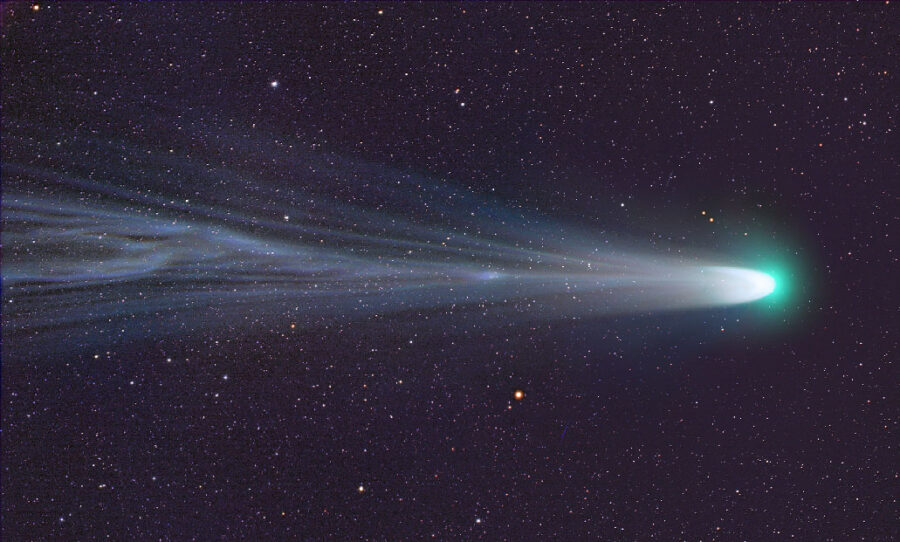
Michael Jäger
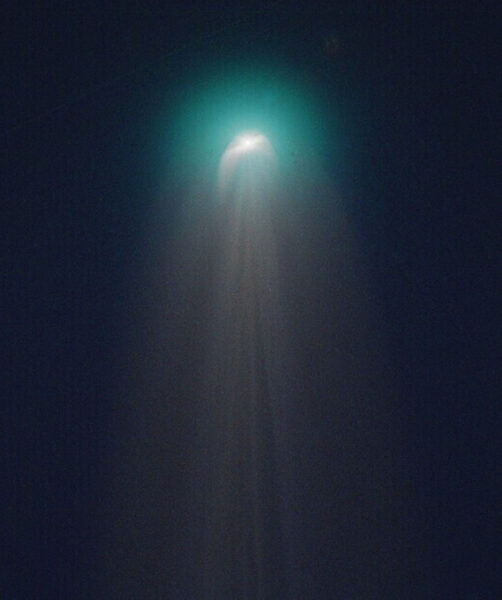
Michael Jäger, Lukas Demetz and Qi Yang
Each flare began with a dramatic brightening of the comet’s “false nucleus” — a bright starlike concentration within the coma. Amateur astronomer Piqui Diaz of Ezeiza, Argentina, noted a condensed but hazy coma on December 19.01 UT, but one night later, the comet’s appearance caught her completely off guard. Expecting to see a fuzzy glow, the coma instead looked like a bright “star” in her 90-mm refractor. The cause of each outburst is likely due to vaporization of fresh, dust-laden ice from solar heating as the comet dashes sunward.
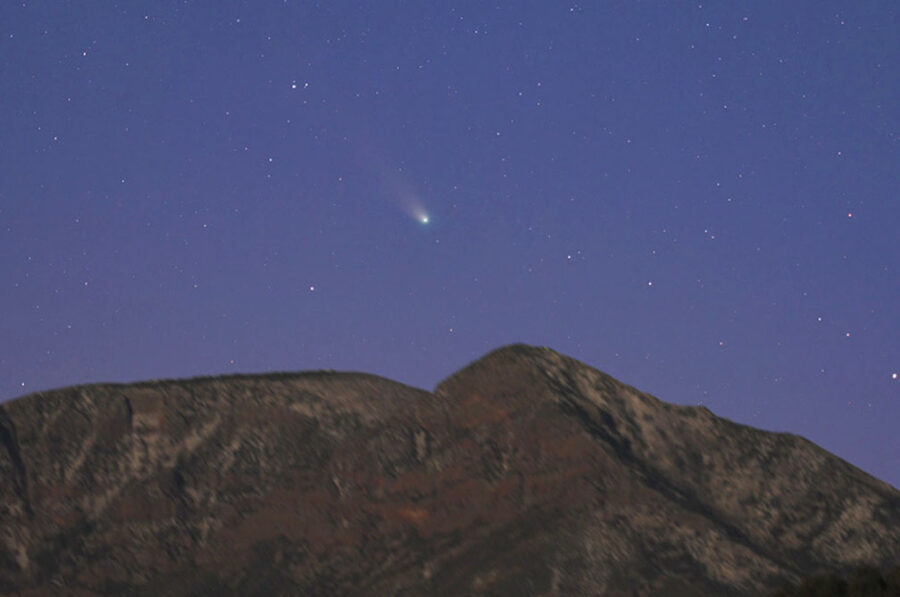
Chris Schur
Comet Leonard currently glows around magnitude 4 and hovers very low in the southwestern sky an hour to 75 minutes after sunset for North American skywatchers. Its altitude depends upon your latitude. From the southern U.S. the comet perches a reasonable 10° to 12° high at mid-twilight and may be faintly visible with the naked eye. But if you live in the northern half of the country, it practically scrapes the horizon with an altitude of just 3° to 5°. You’ll need transparent skies, an unobstructed horizon, and binoculars or a small telescope to see it.

Bob King
You’ll also need to know exactly where to look, and there are few bright stars to guide you there. But don’t despair. Using the planets to make triangles that included the comet at one apex, I spotted the fuzzy blob in binoculars from Duluth, Minnesota (latitude 47° north) on both December 20th and 24th. The camera did better, showing it more clearly than I could see with my eyes. Given the comet’s southern declination, Southern Hemisphere observers have the best view, with this celestial visitor standing 20° (and climbing) 90 minutes after sunset from mid-southern latitudes.
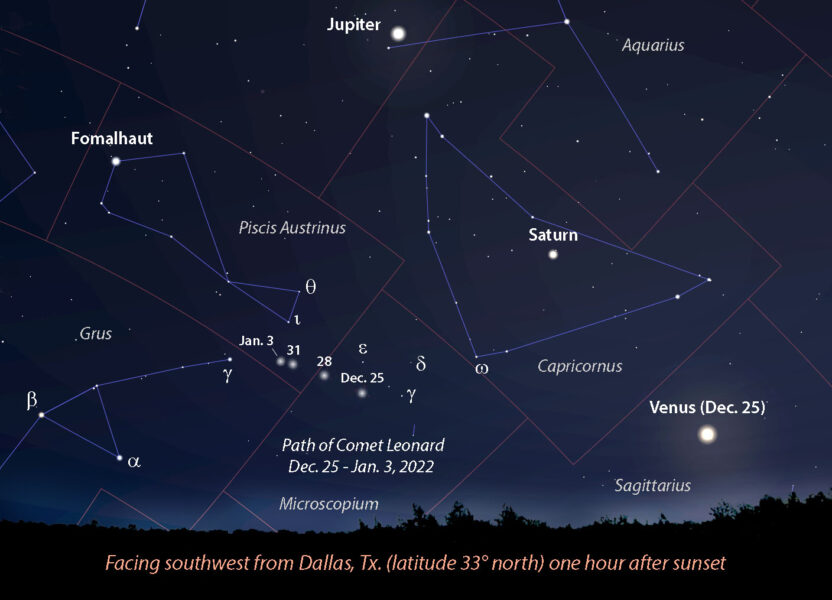
Stellarium with additions by Bob King
If you’re struggling to find the comet, take a photo of where it’s supposed to be. That’s what worked best for me. When it pops up on your display (replay) screen, you’ll know exactly where to point your telescope or binoculars.
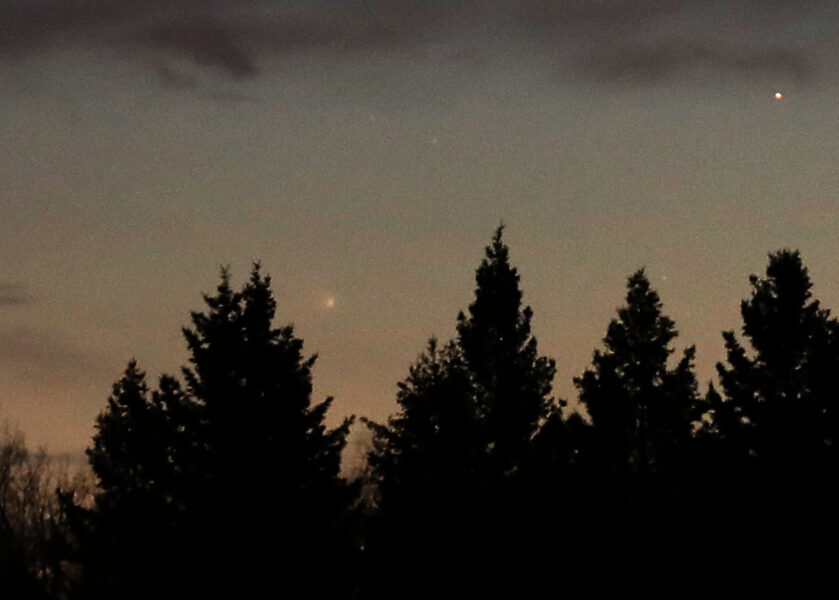
Bob King
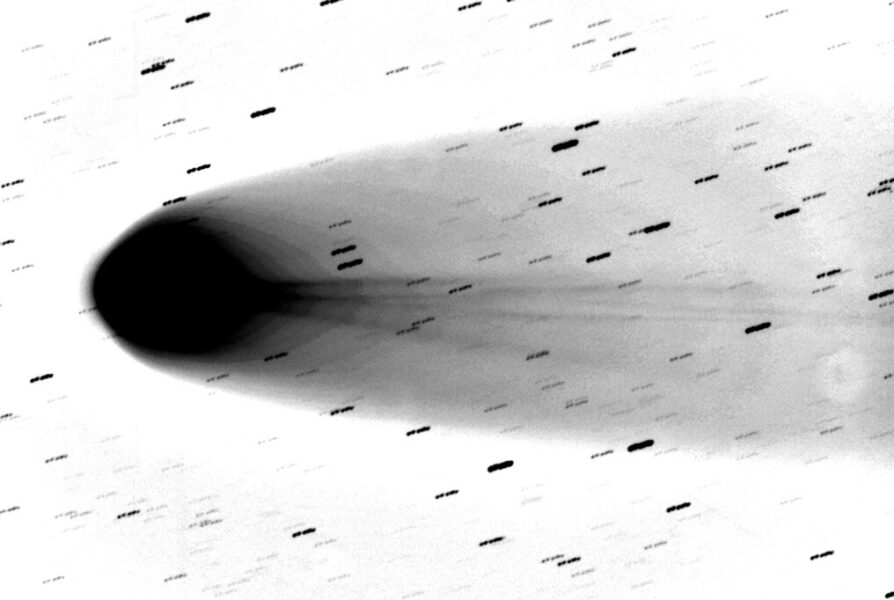
John Drummond

Michael Jäger and Lukas Demetz
Comet Leonard’s ion tail has shown remarkable complexity that you can see for yourself in breathtaking images taken by Austrian astrophotographer Michael Jäger and others. Continuous changes in tail length, along with the appearance of streamers, kinks, and knots, show just how captivating and unpredictable comets can be. And all this from a kilometer-wide berg of dirty ice. Miracles of nature never cease.
 18
18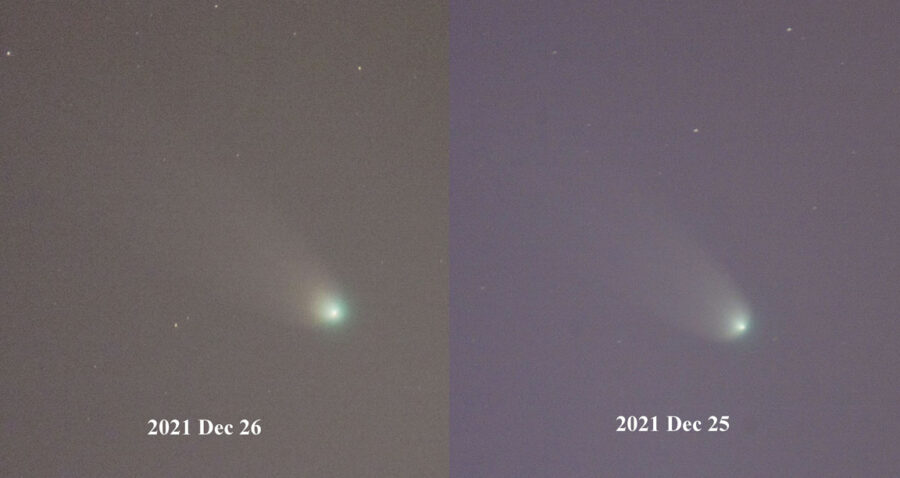










Comments
Anthony Barreiro
December 25, 2021 at 5:55 pm
Here in San Francisco we've been having a spell of mostly cloudy skies and much needed rain. Thursday afternoon 23 December the sky cleared and the rain stopped. Venus was visible before sunset, so I walked up Bernal Hill to look for Comet Leonard. The clouds came back but the sky stayed mostly clear to the southwest. Starting about one hour after sunset and for about 20 minutes, the comet was very easy to see in 10x42 image stabilized binoculars, about 20 degrees left of Venus, 15 degrees lower left of Saturn, and conveniently placed between fifth-magnitude Alpha and Gamma Microscopii. The comet was brighter than these stars, I would guess around fourth magnitude, with a bright center and a nonstellar coma. I kept thinking I could see a hint of the tail pointing away from the Sun, with either averted vision or averted imagination. I tried repeatedly to see the comet naked eye, but no luck. Especially because of the unexpected break in the weather it was a real treat to see the comet.
You must be logged in to post a comment.
Bob KingPost Author
December 25, 2021 at 6:35 pm
Anthony,
Delighted that you saw it. My last good view in Duluth was on a windy, subzero evening (Dec. 20). I found it as described with the camera first and then picked it up in my 10-inch reflector (bright coma, obvious tail to the east) and then binoculars as a tailless blob about 10 arc-minutes across. On Christmas Eve I didn't have enough time to see it in the scope, but it was obvious in 2-second time exposures with the telephoto.
You must be logged in to post a comment.
Anthony Barreiro
December 25, 2021 at 8:45 pm
Thanks Bob. The heads up and finder charts were invaluable!
By the way, this was my third observation of Comet Leonard. I saw it once in the morning as a subtle faint fuzzy, and once before in the evening. Definitely brightest on 23 December.
You must be logged in to post a comment.
Bob KingPost Author
December 26, 2021 at 12:21 am
You're welcome, Anthony. Glad to help.
You must be logged in to post a comment.
Virendersingh
December 26, 2021 at 6:52 am
Hi bob i also saw comet leonard in morning time but yet not able to see in evening time. But yesterday i saw something which i am not able to indentify. Yesterday i saw live telecast of lauch of james webb telescope. Was very excited to see that. Post launch i went to terrace to see stars and suddenly there i saw a comet like object with tail in southern direction . I could not identify it. After certain time i realized its slowly moving towards southeast . I took my dslr out and took multiple pictures. It was moving fast in camera and its tail also changed direction when it reached southeast sky. It slowly fainted away . Intially it was visible with naked eyes and close to alpha sculptoris star.Could it be some part of launch but then how could it has tail.kindly throw some light on this. Comet leonard position is different from this.i can share pictures if you say.
You must be logged in to post a comment.
Bob KingPost Author
December 26, 2021 at 10:50 am
Hello Virender,
Based on your description and timing, it's possible you did see the upper stage and James Webb Space Telescope. There were reports of a similar object — identified as the JWST — from Thailand. Here's a link to the photo: https://bit.ly/32GpnkE Did it resemble this?
You must be logged in to post a comment.
Virendersingh
December 28, 2021 at 12:55 am
Hi bob
Yes my sightings were similar to above pics. It must be telescope or upper stage.But i still have some queries like if it was james webb telescope was it possible to see it from so far with naked eyes. It was already well above 1500km height half an hour after lift off and what was the tail then . And if it was upper stage then it wasnt looking like reentery burn. I live in north india.this is the link of my pics taken https://linksharing.samsungcloud.com/y3xl7Jxlxpgc.
You must be logged in to post a comment.
Household six
December 26, 2021 at 11:41 am
It is time stamped at bottom of each photo.
https://photos.app.goo.gl/YV9DtG3kcyRRdqnX6
You must be logged in to post a comment.
Bob KingPost Author
December 26, 2021 at 12:04 pm
H-six,
Thank you for the photos! I know exactly what you saw. That's the rising half-moon! The time sequence fits perfectly, with moonrise shortly before midnight for your location. Also, the moon would move up and to the right (east to west) as it rose. The reason it appears like a bright light or "star" is because your Ring system uses a super-wide-angle lens for a big picture view. From that perspective, the moon appears small. Also, given the camera's low resolution its shape isn't clear either.
You must be logged in to post a comment.
Household six
December 26, 2021 at 12:30 pm
Thank you so much!!
You must be logged in to post a comment.
Bob KingPost Author
December 26, 2021 at 1:07 pm
You're welcome, H-six! I love little mysteries, especially the solvable kind 🙂
You must be logged in to post a comment.
mary beth
December 27, 2021 at 4:28 pm
So happy to hear you were able to see ! Great report !
You must be logged in to post a comment.
Household six
December 26, 2021 at 10:59 am
I am in central Texas and caught something (a bright light) on my Ring that came up from horizon slowly and sat for sometime before slowly proceeding out of camera view. The event from the camera’s view lasted about 2 hours.
You must be logged in to post a comment.
Household six
December 26, 2021 at 11:05 am
Coming from the East to west.
You must be logged in to post a comment.
Bob KingPost Author
December 26, 2021 at 11:30 am
H-six,
Depending on the time, it's very possible you were seeing the bright, twinkling star Sirius. Only a star would take that long to pass through the field of view of your camera. Was it between about 8 and 10 p.m.?
You must be logged in to post a comment.
Bob KingPost Author
December 26, 2021 at 11:07 am
Dear Household six,
Please tell me what time and date (and direction) you saw this, and I can try to identify it. Do you have a photo you can link to? Also, I'm not clear what you mean by "Ring." Thanks!
You must be logged in to post a comment.
Household six
December 26, 2021 at 11:34 am
Is there anyway to email you a link to my photos?
You must be logged in to post a comment.
Household six
December 26, 2021 at 11:37 am
Ring is our surveillance camera system. The start of the event was about 23:47 until out of cameras view at 02:00.
You must be logged in to post a comment.
You must be logged in to post a comment.